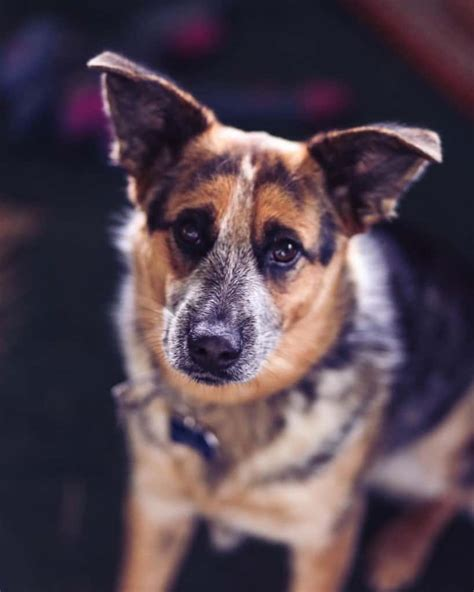Discover if a German Shepherd Blue Heeler mix is right for you. Learn about their exercise needs, temperament, shedding, and more in this comprehensive guide.
As a long-time dog owner and enthusiast, I've had the pleasure of interacting with many different breeds over the years. But it wasn't until I met my neighbor's German Shepherd Blue Heeler mix, Max, that I truly understood the unique charm of this hybrid breed. Max's intelligence, loyalty, and boundless energy left a lasting impression on me, sparking my curiosity to learn more about these fascinating dogs.
The German Heeler: A Powerful Combination
The German Shepherd Blue Heeler mix, often referred to as the German Heeler, is a crossbreed that combines the best traits of two highly intelligent and hardworking breeds. This mix inherits the German Shepherd's loyalty and protective instincts with the Blue Heeler's agility and herding prowess.
Personal Experience with Max
I vividly remember the day Max effortlessly herded a group of children playing in the park, gently guiding them away from a potentially dangerous area near a busy street. His natural instincts, combined with his owner's training, showcased the incredible potential of this mixed breed.

Are German Shepherd Blue Heeler Mixes Good Dogs?
In my opinion, German Shepherd Blue Heeler mixes can make excellent companions for the right owners. Their intelligence, loyalty, and versatility make them well-suited for various roles, from family pets to working dogs. However, it's crucial to understand that these dogs are not for everyone.
Pros of German Heelers:
- High intelligence and trainability
- Loyal and protective nature
- Versatile working abilities
- Strong bond with their family
Cons to Consider:
- High energy levels requiring extensive exercise
- Potential for herding behaviors with children or other pets
- May be wary of strangers if not properly socialized
- Requires mental stimulation to prevent boredom and destructive behaviors
Blue Heeler Exercise Needs
One of the most crucial aspects of owning a German Shepherd Blue Heeler mix is meeting their substantial exercise requirements. Blue Heelers, also known as Australian Cattle Dogs, were bred to work tirelessly on vast cattle ranches. This heritage translates into a dog with seemingly endless energy.
According to the American Kennel Club (AKC), Blue Heelers require at least 1-2 hours of vigorous exercise daily. This need for physical activity is often inherited by German Heeler mixes, making them unsuitable for sedentary lifestyles.
Exercise Ideas for German Heelers:
- Long walks or jogs (at least 30-60 minutes daily)
- Fetch or frisbee sessions
- Agility training
- Swimming
- Herding trials or classes
German Shepherd and Heeler Mix: Temperament and Training
The temperament of a German Shepherd Blue Heeler mix can vary, but generally, these dogs are intelligent, loyal, and protective. They often inherit the German Shepherd's devotion to their family and the Blue Heeler's wariness of strangers.
Training is essential for this mix, as both parent breeds are working dogs that thrive on mental stimulation. Early socialization is crucial to ensure they develop into well-rounded adults.
Training Tips for German Heelers:
- Start training early and be consistent
- Use positive reinforcement techniques
- Provide plenty of mental stimulation through puzzle toys and training exercises
- Enroll in obedience classes or consider working with a professional trainer
Are Blue Heelers Hypoallergenic?
Unfortunately, Blue Heelers and their mixes, including German Heelers, are not hypoallergenic. These dogs have a double coat that sheds moderately throughout the year and more heavily during shedding seasons.
While no dog is truly 100% hypoallergenic, some breeds produce fewer allergens than others. If you're looking for a more allergy-friendly option, consider breeds like the Poodle or Bichon Frise.
German Shepherd Red Heeler: A Variation on the Theme
While Blue Heelers are more common, Red Heelers (also known as Australian Cattle Dogs with a red coat) can also be mixed with German Shepherds. The resulting puppies may have a reddish tint to their coat instead of the blue-gray typically associated with Blue Heelers.
The temperament and care requirements for German Shepherd Red Heeler mixes are generally similar to their Blue Heeler counterparts.
Blue Heeler Shedding: What to Expect
Blue Heelers, and by extension, German Heelers, are moderate to heavy shedders. Their double coat consists of a dense undercoat and a weather-resistant outer coat, which helps protect them in various climates.
According to a study by the Journal of Allergy and Clinical Immunology, regular grooming can significantly reduce the amount of allergens in a dog's coat. While this won't eliminate shedding, it can help manage it.
Tips for Managing German Heeler Shedding:
- Brush your dog 2-3 times a week, increasing to daily during shedding seasons
- Use a deshedding tool during heavy shedding periods
- Bathe your dog every 6-8 weeks, or as needed
- Consider using a high-quality air purifier in your home
The American Kennel Club's Stance
While the German Shepherd Blue Heeler mix is not recognized as a distinct breed by the American Kennel Club (AKC), both parent breeds are well-respected in their own right. The AKC recognizes the German Shepherd in its Herding Group and the Australian Cattle Dog (Blue Heeler) in its Working Group.
The AKC emphasizes the importance of responsible breeding and proper care for all dogs, including mixed breeds. They recommend thorough health testing for parent dogs to reduce the risk of genetic health issues in offspring.
Conclusion: Is a German Shepherd Blue Heeler Mix Right for You?
Reflecting on my experiences with Max and the research I've conducted, I believe German Shepherd Blue Heeler mixes can be wonderful companions for the right owners. Their intelligence, loyalty, and versatility make them excellent working dogs and family pets.
However, these dogs are not for everyone. Their high energy levels, exercise needs, and potential for herding behaviors require an owner who can provide plenty of physical activity, mental stimulation, and consistent training.
If you're an active individual or family with experience handling intelligent, high-energy dogs, a German Heeler might be the perfect fit. But if you're looking for a low-maintenance, apartment-friendly dog, you might want to consider other breeds.
Remember, every dog is an individual, and proper training and socialization are key to bringing out the best in any breed or mix. If you're considering adding a German Shepherd Blue Heeler mix to your family, be sure to meet the dog in person and, if possible, learn about its parents to get a better idea of what to expect.
